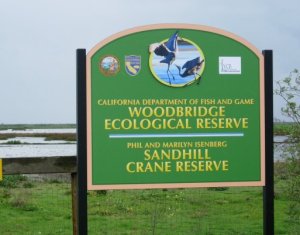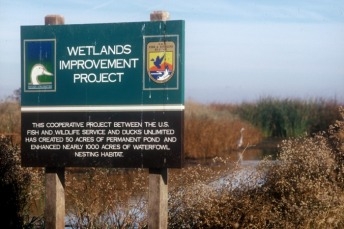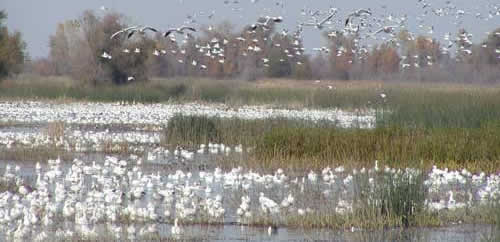How are California's wetlands protected?
California’s unique and vulnerable wetlands are often impacted adversely by human use, and are therefore protected by a combination of regulations, incentives, and grant-funded restoration programs. There are two primary ways in which state, federal, and other agencies within California are protecting wetlands:
- Through programs that regulate the activities that occur within wetlands, and
- Through programs that protect, conserve, and manage wetland resources.
A particular agency may have both a regulatory and resource management role.
Regulation | Incentives | Restoration | How Can I Make a Difference?
Regulation

The primary regulatory tool for protecting wetlands in the United States is Section 404 of the Clean Water Act (CWA), implemented and enforced by the regulatory branch of the U.S. Army Corps of Engineers. This federal law requires that a project that includes changes in land use which might affect wetlands must file for a permit. These permits require the avoidance of all significant negative impacts to the aquatic environment, including the impacted wetlands. If impacts cannot be avoided, then they must be minimized to reduce degradation to the system. Unavoidable impacts must be compensated through creation or restoration of other wetland areas in support of the federal and state no net-loss policies.

The U.S. Environmental Protection Agency (EPA) is responsible for implementing federal laws designed to protect various resources, including wetlands. EPA activities which affect wetlands include, but are not limited to, developing rules to regulate municipal and industrial wastewater discharge, and stormwater discharge; overseeing drinking water quality; and overseeing U.S.ACE regulatory activities pertaining to wetlands protection.
In California, no single agency has authority over all aquatic resources. Regulation of wetlands and streams falls under the authority of six state and federal agencies leading to a complex and varied regulatory structure.

The State Water Resources Control Board and the nine Regional Water Quality Control Boards (Regional Water Boards) are the state’s primary water quality regulatory agencies, tasked with protecting the beneficial uses of the waters of the state under the California Water Code.
The California Coastal Commission is a State coastal management and regulatory agency that, in partnership with local governments, is responsible for implementation of the California Coastal Management Program. The Coastal Commission's primary role in regards to wetland protection is the regulation of coastal development affecting wetlands in California's coastal zone. The Coastal Commission's jurisdiction does not extend into or around San Francisco Bay, where development is regulated by the San Francisco Bay Conservation and Development Commission.![]()
Incentives
 Incentives such as conservation easements encourage landowners to practice conservation. Through easements, landowners agree to leave a portion of their land permanently undeveloped, and in exchange receive tax incentives from the federal and state government. Federal, state, and local agencies work with landowners to set up easements.
Incentives such as conservation easements encourage landowners to practice conservation. Through easements, landowners agree to leave a portion of their land permanently undeveloped, and in exchange receive tax incentives from the federal and state government. Federal, state, and local agencies work with landowners to set up easements.
![]() As an example at the Federal level, the Natural Resources Conservation Service (NRCS) assists in wetlands restoration and enhancement on agricultural lands through programs such as, the Water Bank Program, the Wetlands Reserve Program, the Agricultural Conservation Program, the Conservation Reserve Program, the Resource Conservation and Development Program (RC&D), and the Small Watersheds Program (PL-566). As part of the NRCS's Wetlands Protection Policy, landowners have the option of mitigating wetland impacts from agricultural practices in order to continue receiving NRCS assistance.
As an example at the Federal level, the Natural Resources Conservation Service (NRCS) assists in wetlands restoration and enhancement on agricultural lands through programs such as, the Water Bank Program, the Wetlands Reserve Program, the Agricultural Conservation Program, the Conservation Reserve Program, the Resource Conservation and Development Program (RC&D), and the Small Watersheds Program (PL-566). As part of the NRCS's Wetlands Protection Policy, landowners have the option of mitigating wetland impacts from agricultural practices in order to continue receiving NRCS assistance.
At the State level, the Wildlife Conservation Board is responsible for wetlands protection through the acquisition of fee and lesser interests, such as conservation easements. In addition, the Board assists local agencies, special districts, and nonprofit organizations with cost-share projects which restore and enhance public and privately owned wetlands. It is also responsible for managing the Inland Wetlands Conservation Program. This program assists the Central Valley Joint Venture in meeting specific objectives which protect, restore, and enhance public and privately owned wetlands in the California Central Valley.
The California Department of Fish and Wildlife (CDFW), U.S. Fish and Wildlife Service (USFWS), and even counties also have easement programs. Many NGOs, such as The Nature Conservancy and Ducks Unlimited, collaborate on easement efforts and raise funds to secure property for easements.




Restoration

Also critical to the success of these efforts are voluntary and/or grant funded restoration programs, which account for the vast majority of increases in wetland acreage. Local, state, and federal agencies, in partnership with conservation groups and private landowners, have worked together to develop and increase the capacity for voluntary wetland conservation.


Much of this work has been accomplished through the California Coastal Conservancy and the State Lands Commission along with California’s six habitat-based joint ventures. Joint ventures are public/private partnerships that work entirely through voluntary efforts. Businesses, NGOs, state, regional and federal all participate in these partnerships to protect and enhance wetlands. For example, the Coastal Conservancy supports the work of the Southern California Wetlands Recovery Project (SCWRP), a broad-based partnership that has public agencies, non-profits, scientists, and local communities working cooperatively to acquire and restore rivers, streams, and wetlands in coastal southern California.
Public investment in wetland protection and restoration since 1998 has been facilitated by at least five voter-approved bond measures helping to strengthen the state’s aquatic resources. Proceeds from these bond measures have been combined with other state resources to support the acquisition, protection, and restoration of wetlands across the state.
How Can I Make a Difference?
In addition to larger statewide or regional efforts, there are a number of actions that individuals can take to protect wetlands.
- The best way to understand wetlands is to visit them; find wetlands in your area. The National Wildlife Refuge system provides access to many types of wetlands throughout the State.
- Engage educational opportunities to learn more about the watersheds we live in and how they relate to the local wetlands and the plants and animals that live there, and in particular, about how pollution on land can wash into wetlands and contaminate them.
- Participate in an ongoing volunteer wetland monitoring program, such as Coastal Cleanup Day that encourages the public to take ownership of their local wetlands.
- Take part in wetland habitat restoration projects near your home.
- Maintain a buffer of open space around wetlands on your property.
- Support nonprofit organizations, local conservancies, and public agencies that work to protect wetlands and other waterways.
- Encourage neighbors, developers, and public officials to safeguard wetland integrity and accessibility in your area.
- Participate in California’s regulatory efforts by reviewing public notices and commenting on permit applications that affect wetlands.


